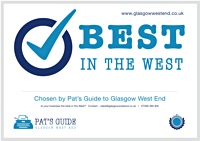On the Cowboy Trail - page three
from Encounters in the US Mountain West; A Sinner amongst the Latter Day Saints, by Ian R. Mitchell - to be published by NWP Publishing in September 2012
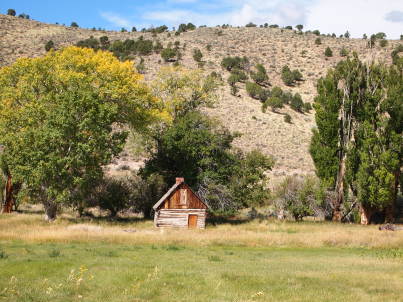 The town- or ghost town- of Grafton lies just outside Zion National Park, towards which it looks. It was set up by the Mormons in an area where they thought they could produce cotton, as part of their early efforts at self-sufficiency. Attempts to live here in an area suitable really neither farming nor ranching were tough; the town was abandoned, re-occupied, then finally abandoned again by the 1920s. Unless things go on fire or are swept away by floods here, they survive, and Grafton today has several buildings still standing including the old school cum church and several farmhouses. The place featured in Butch Cassidy and the Sundance Kid, as one of the duo's hideouts before the modern world finally caught up with them and forced their flight to South America. Grafton features mostly in the bicycle scene, where Butch plays with the new mechanical, industrial toy, the bicycle that symbolises the anachronism of his outlaw life.
The town- or ghost town- of Grafton lies just outside Zion National Park, towards which it looks. It was set up by the Mormons in an area where they thought they could produce cotton, as part of their early efforts at self-sufficiency. Attempts to live here in an area suitable really neither farming nor ranching were tough; the town was abandoned, re-occupied, then finally abandoned again by the 1920s. Unless things go on fire or are swept away by floods here, they survive, and Grafton today has several buildings still standing including the old school cum church and several farmhouses. The place featured in Butch Cassidy and the Sundance Kid, as one of the duo's hideouts before the modern world finally caught up with them and forced their flight to South America. Grafton features mostly in the bicycle scene, where Butch plays with the new mechanical, industrial toy, the bicycle that symbolises the anachronism of his outlaw life.
Butch Cassidy and the Sundance Kid, made in 1969, and starring Paul Newman and Robert Redford, was filmed mostly in Utah, around Grafton and in Snow Canyon and in Zion, which is appropriate as the Wild Bunch which they led operated in and out of southern Utah. There are almost as many haunts associated with the gang, as there are caves in Scotland where Bonnie Prince Charlie is supposed to have slept. They operated at the very end of the outlaw period, in the 1890s, and as outlaws went were not really a Bad Bunch, killing as little as possible and actually occasionally remembering that as well as robbing the rich, they were supposed to help the poor. Butch in particular hated violence, which some say was due to him Mormon upbringing (not really dealt with in the film), and is reputed never to have killed anyone or even carried a weapon (though other gang members did.) It was almost a hippy love and peace cowboy film, a welcome antidote to, for example, Clint Eastwood's slightly later western productions, which consisted of little more than the celebration of psychopathic killing. Butch Cassidy and the Sundance Kid was to leave Utah a legacy in the Sundance Institute and Sundance Festival, set up by Robert Redford in 1981 as a crucible for independent film.
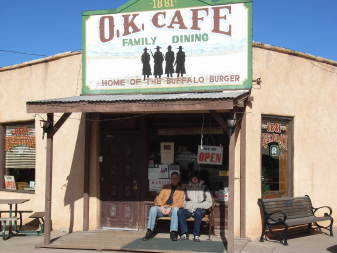 Back in Kanab I went looking for an eatery. I had survived most of the previous two days on biscuits and coffee. It clearly wasn't high tourist season in the town, and most places were closed, but I found one- at 5 o'clock - that had an hour of its opening time left. It was a basic cafe serving burgers and various pies. I was to find again that this kind of fare was usually a fairly safe bet in an otherwise gastronomic hazard zone. At 6 o'clock they were closing the joint. It was New Year's Eve, and I innocently asked the waitress if the event was celebrated locally in any way. She looked at me with a puzzled and slightly worried look, then said,
Back in Kanab I went looking for an eatery. I had survived most of the previous two days on biscuits and coffee. It clearly wasn't high tourist season in the town, and most places were closed, but I found one- at 5 o'clock - that had an hour of its opening time left. It was a basic cafe serving burgers and various pies. I was to find again that this kind of fare was usually a fairly safe bet in an otherwise gastronomic hazard zone. At 6 o'clock they were closing the joint. It was New Year's Eve, and I innocently asked the waitress if the event was celebrated locally in any way. She looked at me with a puzzled and slightly worried look, then said,
"No, folks hereabouts just go to church and then to their beds", then adding, "But I think they might do some kinda thing in Salt Lake, or so I've heard." Salt Lake was a long way to go to bring in the bells, so I wended by way back to Parry Lodge for an early night, hopefully to dream of Barbara Stanwyck as my first foot. That was when I thought, that for Hogmanay entertainment, I should have stayed in Williams, Arizona -where I had just been before Kanab.
Williams was once a Highway 66 transit town, and it trades on this as well as being a southern gateway to the Grand Canyon. There are a couple of Soda Fountain-style cafes that are as phoney as Mom's in Salina is real, but the visitors possibly don't know or care. A tourist steam train leaves the town daily for the canyon, with a staged cowboy shootout preceeding it. It had been my last stop in Arizona before heading northwards to Utah, and I wasn't initially too enamoured with the place. However, I left it with a great regret, and one day I might get back to rectify this. In my hotel there were various brochures which I picked up and I was leafing through these as I had my milkshake and burger in Cruisers Cafe 66. One handbill especially caught my eye. It was promoting Williams Cowboy Church, which was to have a service on New Years Eve, (that very night only two days later when I was Aimless in Kanab). "Start the New Year with your foot in the strirrup", it advised. "Settle your debts with God". I would have had to wait two days to attend it, but I was sorely tempted when I read on.
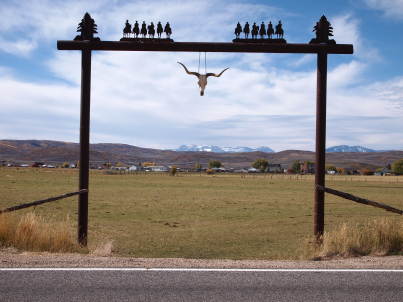 As well as offering a Cowboy Preacher, who was riding (on a real horse) into town especially for the occasion, the event would host Gospel Music in addition to Cowboy Hymns and Poetry. For those seeking to come to the Lord and assure themselves a place in the Great Bunkhouse in the Sky, there would be - horse trough baptisms! Evenings can be cold even in Arizona at this time of year, and for anyone hesitant about meeting their Saviour via immersion in chilly water there was the option of Hot Water Baptisms, for $10. This concession to softies probably tipped the balance against my waiting in Williams for two days for assured salvation. It went against the Presbyterian grain of my upbringing. The Lord could not be mocked. He would know the cold water true believer from the heated water false one. This was not the True Church. But it might have been more fun than New Year's Eve in Kanab.
As well as offering a Cowboy Preacher, who was riding (on a real horse) into town especially for the occasion, the event would host Gospel Music in addition to Cowboy Hymns and Poetry. For those seeking to come to the Lord and assure themselves a place in the Great Bunkhouse in the Sky, there would be - horse trough baptisms! Evenings can be cold even in Arizona at this time of year, and for anyone hesitant about meeting their Saviour via immersion in chilly water there was the option of Hot Water Baptisms, for $10. This concession to softies probably tipped the balance against my waiting in Williams for two days for assured salvation. It went against the Presbyterian grain of my upbringing. The Lord could not be mocked. He would know the cold water true believer from the heated water false one. This was not the True Church. But it might have been more fun than New Year's Eve in Kanab.
There are cowboys (and some very cute cowgirls) everywhere in Arizona. It is a state where you are allowed to carry a gun visibly, so many of them are armed with holsters and six guns. But they don't drive cattle, they drive huge gas-guzzling macho- mobiles, and the clothes they wear are expensive designer items. Everywhere are Cowboy Outfitters where very expensive leather goods are sold to the pretend cowboys of Arizona and their gals. If they do ride horses, it is for recreational purposes, back on their country acres. At least that's how it was in the places I visited, doubtless in the sticks of the back country you can find real cowboys in Arizona.
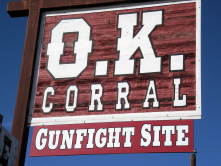 Arizona of course features heavily in the Western movie canon, with none more famous than Gunfight at the OK Coral, set in Tombstone. Americans can take virtual reality to a pitch of perfection no one else can, maybe because the distinction between fantasy and reality is finer with them than with most others. Though it is pure hoakum, there is no way you should miss a visit to this Arizona town, "too tough to die" - and living very well on tourism. From a scratch in the sand Tombstone had become a rip-roaring silver mining town of 10,000 people in 1881 a few years later with 100 saloons most of which were brothels. This included the Bird Cage Theatre, where Shakespeare was not performed, but where prostitutes strutted their stuff in cages suspended from the roof. The most famous shoot out in history took place here in 1881 when Wyatt Earp, his brother and Doc Holliday summarily executed three members of the Clanton gang in as many minutes at the OK Coral, an event for which Earp was later put on trial.
Arizona of course features heavily in the Western movie canon, with none more famous than Gunfight at the OK Coral, set in Tombstone. Americans can take virtual reality to a pitch of perfection no one else can, maybe because the distinction between fantasy and reality is finer with them than with most others. Though it is pure hoakum, there is no way you should miss a visit to this Arizona town, "too tough to die" - and living very well on tourism. From a scratch in the sand Tombstone had become a rip-roaring silver mining town of 10,000 people in 1881 a few years later with 100 saloons most of which were brothels. This included the Bird Cage Theatre, where Shakespeare was not performed, but where prostitutes strutted their stuff in cages suspended from the roof. The most famous shoot out in history took place here in 1881 when Wyatt Earp, his brother and Doc Holliday summarily executed three members of the Clanton gang in as many minutes at the OK Coral, an event for which Earp was later put on trial.
Continue reading On the Cowboy Trail
from Encounters in the US Mountain West; A Sinner amongst the Latter Day Saints, by Ian R. Mitchell - to be published by NWP Publishing in September 2012







